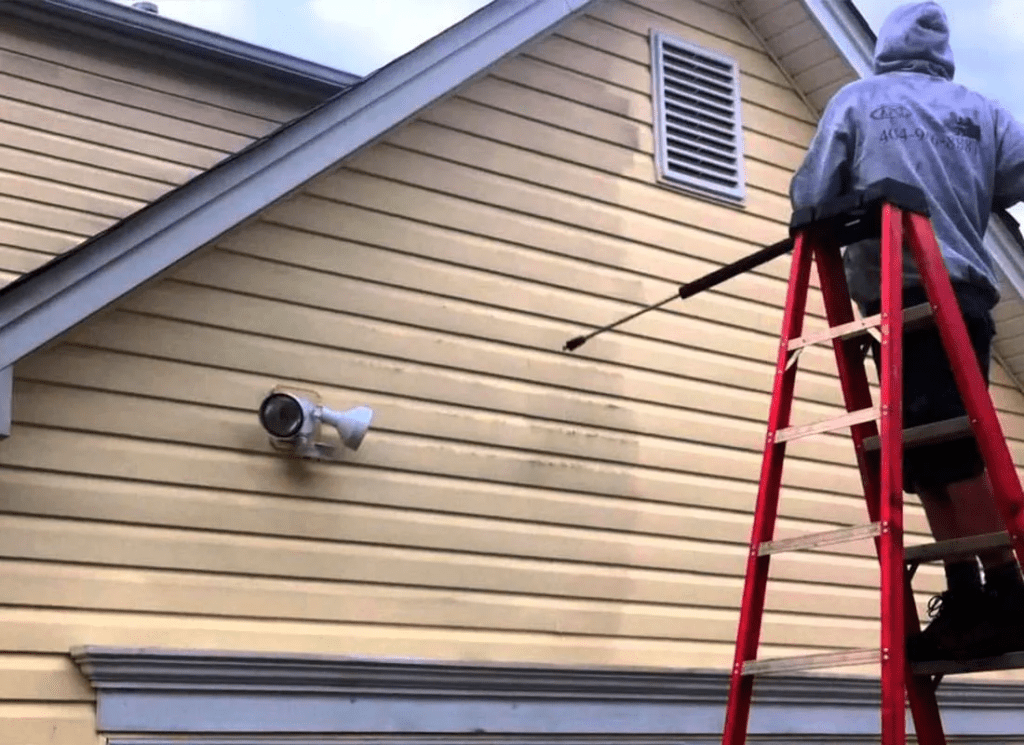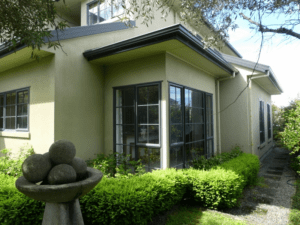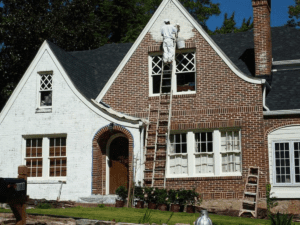
Image Source: Unsplash
## Understanding the Purpose of Pressure Washing
Pressure washing is a crucial step in preparing your house for painting. It involves using a high-pressure stream of water to clean the exterior surfaces, removing dirt, grime, and loose paint. The primary goal of pressure washing is to create a clean and smooth surface that allows the paint to adhere properly. By removing any contaminants and loose materials, you ensure a better bond between the paint and the surface, resulting in a longer-lasting and more visually appealing paint job.
Assessing the Extent of Surface Preparation Required
Before determining how long you should wait to paint after pressure washing, it is essential to assess the extent of surface preparation required. Inspect the surfaces carefully for any remaining loose paint, cracks, or damaged areas. If there are extensive areas of peeling or flaking paint, you may need to consider additional steps such as scraping, sanding, or even using a paint stripper to remove the old paint completely. The more thorough the surface preparation, the better the results of your paint job.
Factors Affecting Drying Time After Pressure Washing
The drying time after pressure washing depends on various factors. The porosity of the surface plays a significant role in determining how quickly it dries. For example, concrete or brick surfaces may dry faster than wood or stucco. The weather conditions, including temperature, humidity, and air circulation, also affect drying time. Additionally, the type of pressure washer used and the pressure applied can influence how much water is left on the surface after washing, impacting the drying time as well.
Weather Conditions and Their Impact on Drying
Weather conditions are crucial in determining how long you should wait to paint after pressure washing. Ideally, you should choose a day with mild temperatures, moderate humidity, and good air circulation. High temperatures and low humidity can cause the water to evaporate quickly, speeding up the drying process. However, if it is too hot, the water may evaporate too rapidly, leaving the surface unevenly dried. On the other hand, low temperatures and high humidity can prolong the drying time, leading to potential issues with adhesion and paint durability.
Differences in Drying Times for Various Surfaces
Different surfaces have varying drying times after pressure washing. For example, concrete surfaces typically dry faster than wood or stucco. This is because concrete is less porous and absorbs less water. Wood, on the other hand, is more porous and may retain moisture for a longer period. Stucco can also take longer to dry due to its textured surface, which traps water more easily. Understanding the specific drying characteristics of the surfaces you are working with is essential in determining the appropriate waiting period before painting.
Recommended Waiting Periods for Specific Paint Types
The type of paint you plan to use also affects how long you should wait to paint after pressure washing. Latex or water-based paints generally dry faster than oil-based paints. As a general guideline, it is recommended to wait at least 24-48 hours after pressure washing before applying latex paint. However, oil-based paints may require a longer waiting period of 48-72 hours. Always refer to the manufacturer’s instructions for the specific paint you are using, as they may provide more precise recommendations regarding drying times.
Checking for Adequate Surface Dryness Before Painting
Before proceeding with painting, it is crucial to ensure that the surface is adequately dry. To check for dryness, you can perform a simple moisture test. Press a piece of plastic wrap firmly against the surface and leave it in place for a few minutes. If condensation forms on the underside of the plastic wrap, the surface is still too wet to paint. However, if the plastic wrap remains dry, the surface is likely ready for painting. It is always better to err on the side of caution and allow for additional drying time if there is any doubt.
Potential Consequences of Painting on Insufficiently Dry Surfaces
Painting on surfaces that are not sufficiently dry can lead to various issues and compromise the longevity of your paint job. If the surface is still damp, the paint may not adhere properly, resulting in poor adhesion and an uneven finish. Moisture trapped beneath the paint can also lead to blistering, peeling, or bubbling over time. Additionally, painting on a damp surface can create an ideal environment for mold or mildew growth, which can damage both the paint and the underlying structure. Taking the time to ensure the surface is adequately dry is essential for a successful paint job.
Preparing the Surface for Optimal Paint Adhesion
Apart from waiting for the surface to dry, there are other steps you can take to ensure optimal paint adhesion. After pressure washing, it is recommended to inspect the surface again for any remaining loose paint or debris. Use a scraper or sandpaper to remove any flaking or peeling paint. Smooth out any rough or uneven areas with sandpaper, ensuring a clean and even surface for painting. Additionally, consider applying a primer before painting, especially if the surface has extensive repairs or is porous. A primer helps improve paint adhesion and enhances the durability of the paint job.
Precautions for Painting in Humid or Damp Conditions
If you live in a humid or damp climate, painting after pressure washing requires extra precautions. High humidity can slow down the drying process, and the excess moisture in the air can affect the paint’s ability to cure properly. To mitigate these risks, choose a low humidity day for painting and ensure good ventilation to help expedite the drying process. If necessary, you can use dehumidifiers or fans to reduce the humidity in the area. It is also crucial to monitor the weather forecast and avoid painting if rain is expected within the next 24-48 hours.
Balancing Timelines for Painting Projects with Drying Requirements
When planning a painting project, it is essential to balance the timelines for pressure washing and drying requirements. Ideally, pressure wash the surfaces a few days before you plan to start painting to allow for ample drying time. This ensures that the surface is thoroughly dry and ready for painting. However, avoid pressure washing too far in advance, as the surface may accumulate dirt or contaminants again, requiring additional cleaning. Finding the right balance between pressure washing and painting timelines is crucial for achieving the best results.
Tips for Efficient Scheduling of Pressure Washing and Painting
Efficient scheduling of pressure washing and painting can help streamline your project and minimize downtime. Consider the weather forecast and plan your pressure washing and painting days accordingly. Aim to pressure wash on a day with mild temperatures and moderate humidity, allowing for optimal drying conditions. Once the surface is dry, proceed with painting on a day with similar weather conditions. By planning ahead and scheduling your project efficiently, you can ensure a smooth and successful painting experience.
Professional Recommendations and Industry Best Practices
Professional painters often abide by specific recommendations and industry best practices when it comes to the waiting period after pressure washing. While the exact waiting time may vary based on different factors, including the type of surface and paint, a general guideline is to wait at least 24-48 hours before painting. This allows sufficient time for the surface to dry thoroughly and ensures the best possible results. However, it is always advisable to consult with a professional or refer to the paint manufacturer’s instructions for more specific recommendations based on your unique project requirements.
Alternative Surface Preparation Methods and Their Drying Times
While pressure washing is a popular and effective method for surface preparation, there are alternative methods available, each with varying drying times. Some alternatives include hand scrubbing, chemical cleaning, or using a wire brush. These methods may require different waiting periods before painting, depending on the surface and the cleaning agent used. It is essential to research and understand the specific drying times associated with these alternatives to ensure proper surface preparation and optimal paint adhesion.
By following these guidelines and understanding the factors that affect drying time after pressure washing, you can make informed decisions and achieve a successful paint job. Remember to consider the specific requirements of the surfaces and paints you are working with, as well as the weather conditions and drying techniques. Patience and thoroughness in surface preparation will ultimately lead to a more durable and visually appealing paint finish. So, take the necessary time to allow the surface to dry adequately before proceeding with painting, and enjoy the long-lasting results of your efforts.
CTA: Contact us for professional painting services and expert advice on surface preparation and painting timelines.



